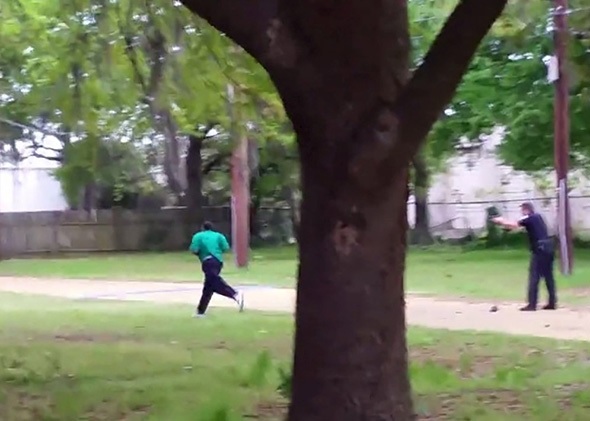The recent spate of killings of unarmed young Black men in the U.S. has been drenched in the racism that remains a key element in the structure of American society. From 12-year-old Tamir Rice to Eric Garner to Walter Scott to Freddie Gray, four recent victims of police violence, the dismal story is the same: cop(s) kill with little or no provocation, and — until recently — have received cover from the judicial system as a whole.
Perhaps the most egregious example of summary executions by police — until the Walter Scott video surfaced, anyway — are the so-called “Houdini suicides.” Young men of colour, having already been searched, their hands cuffed behind their backs, somehow manage to produce a firearm and shoot themselves dead. In one case, a coroner stated that the bullet had actually entered the man’s chest from the front, but ruled the death a suicide anyway.
The fact that Black officers have been involved in some of this latter-day lynching — three of the six Baltimore cops now facing charges in the death of Freddie Gray are African American — does not neutralize the unequal power relations between Black communities and the largely white establishments that rule over them. As we have seen in Ferguson and other nearby communities (and who knows how many others), Black populations can be subject to vicious, organized shakedown rackets enforced by the local police. Casual police brutality is commonplace. When Blacks join police forces, they likely have to prove that they are “colour-blind” and as willing to brutalize their fellow citizens as other officers: certainly life for many Black officers can be made very difficult indeed by their white colleagues in any case, reinforced by deeply racist police departments.
But at this point even conservative commentators, so fond of using that new n-word substitute “thug” to describe unarmed victims of these lynch mobs in blue, are beginning to scratch their heads. The ubiquity of cellphone cameras has made the benefit-of-the-doubt default position for cops near-impossible to maintain.
A little caution, however, should be injected into the discussion at this point. There have been innumerable incidents of unsanctioned police brutality that have nothing to do with race, first of all, and they haven’t all taken place south of the border.
Think about the G20 protests in Toronto, for example, with the mass suspension of civil liberties by former Toronto Police Chief (and now federal Liberal candidate) Bill Blair. Illegal arrests, “kettling” and savage beatings of unarmed demonstrators were not, by and large, an expression of white supremacy. Nor was the brutalization of Tonie Farrell by a member of the OPP, or the gunning down of Sammy Yatim by a trigger-happy Toronto cop, or the electrocution death of Robert Dziekanski by four RCMP officers, or the assault on a woman by Ottawa cop Steve Desjourdy (who had previously roughed up another woman in custody). Then there was the killing of Ian Bush in B.C.: in this case one might want to use the term “Houdini homicide.”
Accountability? It is to weep. In Ontario, the Special Investigations Unit, which is supposed to investigate serious injuries and deaths arising from police-public interactions, has operated as a cover-up machine. Ontario’s civilian review agency, the Office of the Independent Police Review Director (OIPRD) does not inspire confidence either. Rotten apples are rewarded with promotions.
On the rare occasions that bad cops get charged with anything, a different metric is applied. The killers of Robert Dziekanski were charged — with perjury. Two of the four were convicted, and two acquitted. One of the cops went on to kill again, which was a little too much even for the RCMP, who cashiered him shortly afterwards. One of only two cops charged with offences during the extended police riot at the G20 in Toronto — he brutally beat a protester, on camera — avoided any jail time. In Ottawa, a friend of mine was Tasered by a violent police officer as he was lying face-down on the ground, handcuffed, after being falsely arrested. He won a rare victory in front of the highest police standards office in Ontario — and the officer was given a reprimand.
In one appalling case in 2003, a Toronto cop sucker-punched a Somalian immigrant and then tried to frame him for assault, which could have led to the man’s jailing and deportation. This was before camera phones, but someone caught the whole thing on videocam. Bill Blair made a special order that the officer should continue to receive full pay after he was convicted. After years of appeals, he served a 30-day sentence — on weekends.
What is the real problem with out-of-control police? A lack of any accountability mechanism that would rein them in. And that’s not just a matter of effective, accessible civilian review, which many, including a group I have been involved with, have demanded, with indifferent success. There is also a serious problem with the judicial culture, which too often places police above the law, or at least to one side of it.
Perhaps the only effective means of countering police excesses is, then, what we are seeing right now — citizens armed with cell-phones, and the amplification provided by social media. If “a riot is the language of the unheard,” as Martin Luther King put it, folks at the bottom of the social pyramid are now finding their unambiguous, unified voice — and a national audience.
Image: YouTube




